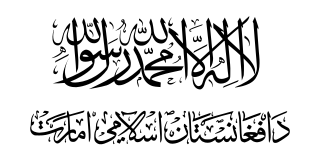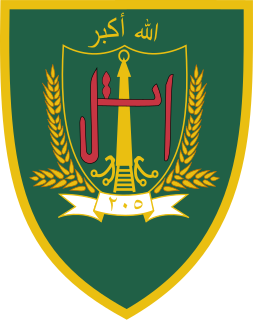
Mohammad Ismail Khan is an Afghan former politician who served as Minister of Energy and Water from 2005 to 2013 and before that served as the governor of Herat Province. Originally a captain in the national army, he is widely known as a former warlord as he controlled a large mujahideen force, mainly his fellow Tajiks from western Afghanistan, during the Soviet–Afghan War. His reputation gained him the nickname Lion of Herat. Ismail Khan was a key member of the now exiled political party Jamiat-e Islami and of the now defunct United National Front party. In 2021, Ismail Khan returned to arms to help defend Herat from the Taliban's offensive, which he and the Afghan Army lost. He was then captured by the Taliban forces and then reportedly fled to Iran on 16 August 2021.

The military of Afghanistan originated in 1709 when the Hotaki dynasty was established in Kandahar followed by the Durrani Empire. The Afghan military was re-organized with assistance from the British in 1880, when the country was ruled by Amir Abdur Rahman Khan. It was modernized during King Amanullah Khan's rule in the early 20th century, and then during King Zahir Shah's forty-year rule; the Soviet Union supplied almost all weapons, training and military needs between the 1950s and 1970s. From 1978 to 1992, the Soviet-backed Afghan Armed Forces engaged in heavy fighting with the multi-national mujahideen groups who were then backed by the United States, Pakistan and others. After President Najibullah's resignation in 1992 and the end of Soviet support, the Afghan military dissolved into portions controlled by different factions. This era was followed by the Taliban regime, whose leaders were trained and influenced by the Pakistan Armed Forces.

The International Security Assistance Force (ISAF) was a multinational military mission in Afghanistan from 2001 to 2014. It was established by United Nations Security Council Resolution 1386 pursuant to the Bonn Agreement, which outlined the establishment of a permanent Afghan government following the U.S. invasion in October 2001. ISAF's primary goal was to train the Afghan National Security Forces (ANSF) and assist Afghanistan in rebuilding key government institutions; however, it gradually took part in the broader war in Afghanistan against the Taliban insurgency.
The Afghan Army is the land warfare branch of the Afghan Armed Forces. The roots of an army in Afghanistan can be traced back to the early 18th century when the Hotak dynasty was established in Kandahar followed by Ahmad Shah Durrani's rise to power. It was reorganized in 1880 during Emir Abdur Rahman Khan's reign. Afghanistan remained neutral during the First and Second World Wars. From the 1960s to the early 1990s, the Afghan Army was equipped by the Soviet Union.

Kapisa is one of the 34 provinces of Afghanistan. The province of Kapisa has a population of approximately 488 000. The main ethnic groups in Kapisa are Tajik, Pashtun, and Nuristani. The province is situated in central-eastern Afghanistan, surrounded by the provinces of Panjshir, Laghman, Kabul and Parwan. Kapisa is divided in seven districts.Mahmmod Raqi is the center of Kapisa, it is an ancient historical province which 620 years ago was the summer capital of Kanishka and on that time India, Bangladesh and Pakistan has been controlled from Kapisa province A primary road connects the capital of Kapisa to Kabul City. The province is considered of strategic importance due to its location.The province covers an area of 1,842 km2 (711 sq mi) making it the smallest province in the country, however it is the most densely populated province apart from Kabul Province. Clashes have been reported in the province since the 2021 Taliban takeover of Afghanistan.

Below is the disposition and structure of international military forces that were participating in the War in Afghanistan in November 2012, listing deployed units under the command of the International Security Assistance Force (ISAF), which controlled both combat and reconstruction operations. During its existence from 2001 to 2014, ISAF comprised units from many countries. In this article, units are assumed to be from the United States unless otherwise stated. This list is a rough and unofficial listing of units and formations.

Shindand Air Base is an Afghan Air Base located in the western part of Afghanistan in the Shindand District of Herat Province, 7 miles northeast of the city of Shindand. The runway has a concrete surface. An all weather asphalt road connects it with the Kandahar–Herat Highway, part of Highway 1. The base is of great strategic importance being just 75 miles from the border of Iran. It is capable of housing over one hundred military aircraft.
The following lists events that happened during 2004 in Afghanistan.

The Afghan National Army Commando Corps was a commando force of the Afghan National Army (ANA). During the Taliban insurgency, the commandos comprised 7% of the Afghan National Security Forces but conducted 70% to 80% of the fighting. The unit structure was based on the 75th Ranger Regiment.
United States and NATO International Security Assistance Force (ISAF) operations, alongside Afghan National Army forces, continued against the Taliban through 2008.

Task Force Phoenix, or more properly known as Combined Joint Task Force Phoenix, was an international military formation. It was organized by the United States Central Command (CENTCOM) in 2003-2004 to train and mentor the newly created Afghan National Army/Afghan National Security Forces (ANSF) to establish and maintain law and order throughout Afghanistan using Embedded Training Teams or ETTs.

The Fall of Kandahar took place in 2001 during the War in Afghanistan. After the fall of Mazar-i-Sharif, Kabul and Herat, Kandahar was the last major city under Taliban control. Kandahar was where the Taliban movement had originated and where its power base was located, so it was assumed that capturing Kandahar would be difficult. The city fell after several weeks of fighting to a force of local militia under Pashtun military commanders and their American advisers. The fall of Kandahar signaled the end of organized Taliban control of Afghanistan.

The 205th 'Atul' (Hero) Corps was a corps-level formation of the Afghan National Army. The establishment of the corps started when the first commander, Gul Aqa Nahib, and some of his staff were appointed on 1 September 2004. The corps was officially established in Kandahar on 19 September 2004. Its headquarters was in Kandahar and it was responsible for the south of the country, partnered with the ISAF's Regional Command South. The Corps was led by Brigadier General Abdul Hamid who replaced General Sher Mohammad Zazai, after a period with Rahmatullah Raufi in command.
Train Advise Assist Command – East was a multinational military formation, part of NATO's Resolute Support Mission within Afghanistan. Until 2014 it was designated Regional Command East, part of the International Security Assistance Force (ISAF). The United States Army provided the force headquarters. The command headquarters was located in Laghman Province.

General Khodaidad is a former Minister of Counter Narcotics of Afghanistan.

The 207th 'Zafar' (Victory) Corps was a corps of the Afghan National Army. It was headquartered at Camp Zafar, Herat, in Herat Province in the west of Afghanistan.

The Afghan National Army Special Operations Command (ANASOC) was a special forces formation of the Afghan National Army, established in 2011 and effectively dispersed after the defeat of the government by the Taliban in 2021.
The 203rd 'Tandar' (Thunder) Corps was a corps of the Afghan National Army (ANA), headquartered in Gardez. The last corps commander was Brigadier General Harab Khanullah Shuja. The original Gardez Regional Command was established on 23 September 2004.

Lt. Gen. Murad Ali Murad is a military personnel in Afghanistan, previously serving as Deputy Interior Minister for Security. The ceremony took place at the Ministry of Defense on 18 May 2017.

After the formation of the Karzai administration in late 2001, the Afghan Armed Forces were gradually reestablished by the United States and its allies.















